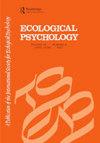Places: Widening the Scope of an Ecological Approach to Perception–Action With an Emphasis on Child Development
IF 1.8
3区 心理学
Q3 PSYCHOLOGY, EXPERIMENTAL
引用次数: 33
Abstract
ABSTRACT An animal's habitat is filled with places that support activities in daily life. There are places, for example, that afford sleeping, eating, hiding, and gathering with others. Most places reflect the environment's nested structure. Even as perception–action is coupled to structure at the level of affordances, it is also coupled especially in human societies to dynamic structures at the level of places within which affordances are nested. These places have a distinctive complexity arising from the collective actions of individuals. For this reason, place-specific activities in human habitats are nearly always embedded in collective social practices. If children are to function adaptively as social beings in the community where they develop and live from day to day, they must learn not only where such places are located but also and critically how to participate in them. Owing to shared intersubjective intentions that give rise to places as behavior settings, individuals' actions in community settings are normatively constrained in the course of their participating in those settings. Consideration of the place within which perception–action is nested is indispensable if we hope to attain an adequate understanding of human perception–action in community settings as well as in some of the settings where research is conducted.地点:扩大感知的生态方法的范围——以儿童发展为重点的行动
摘要动物的栖息地充满了支持日常活动的地方。例如,有些地方负担得起睡觉、吃饭、躲藏和与他人聚会的费用。大多数地方都反映了环境的嵌套结构。即使感知-行动在可供性层面与结构耦合,它也在可供物嵌套的地方层面与动态结构耦合,尤其是在人类社会中。这些地方由于个人的集体行动而具有独特的复杂性。因此,人类栖息地中的特定场所活动几乎总是嵌入集体社会实践中。如果儿童要在他们日常发展和生活的社区中适应社会生活,他们不仅必须学习这些地方的位置,还必须批判性地学习如何参与其中。由于共同的主体间意图产生了作为行为环境的场所,个体在社区环境中的行为在参与这些环境的过程中受到规范性的约束。如果我们希望在社区环境以及一些进行研究的环境中充分理解人类的感知-行动,那么考虑感知-行动的嵌套位置是必不可少的。
本文章由计算机程序翻译,如有差异,请以英文原文为准。
求助全文
约1分钟内获得全文
求助全文
来源期刊

Ecological Psychology
PSYCHOLOGY, EXPERIMENTAL-
CiteScore
3.30
自引率
10.50%
发文量
8
期刊介绍:
This unique journal publishes original articles that contribute to the understanding of psychological and behavioral processes as they occur within the ecological constraints of animal-environment systems. It focuses on problems of perception, action, cognition, communication, learning, development, and evolution in all species, to the extent that those problems derive from a consideration of whole animal-environment systems, rather than animals or their environments in isolation from each other. Significant contributions may come from such diverse fields as human experimental psychology, developmental/social psychology, animal behavior, human factors, fine arts, communication, computer science, philosophy, physical education and therapy, speech and hearing, and vision research.
 求助内容:
求助内容: 应助结果提醒方式:
应助结果提醒方式:


